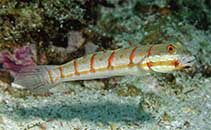| Family: |
Gobiidae (Gobies), subfamily: Gobiinae |
| Max. size: |
20 cm SL (male/unsexed) |
| Environment: |
reef-associated; marine; depth range 2 - 84 m |
| Distribution: |
Indo-Pacific: Red Sea to Samoa, north to southern Japan, south to the Great Barrier Reef and New Caledonia. |
| Diagnosis: |
Dorsal spines (total): 7-7; Dorsal soft rays (total): 11-12; Anal spines: 1-1; Anal soft rays: 11-12. Characterized by pale grey body color for Pacific fish with row of large orange spots on side, a series of dash-like markings below, smaller orange spots on back and blue to whitish streaks or spots on head; Indian Ocean fish with pale blue-grey body color with orange stripe across lower head, cheeks with blue markings and orange bars on side connected to pale orange stripe on lower half; third dorsal spine, longest, filamentous in juveniles under 40 mm SL; rounded caudal fin, 3.0-4.2 in SL; longitudinal scale series 79-91; ctenoid body scales, becoming cycloid anteriorly before first dorsal fin, on lower side, and midline of abdomen; head or midline of nape without scales; side of nape with scales extending forward to above middle of operculum; scaleless pectoral fin base; partly to fully scaled prepelvic area; depth of body 4.8-6.0 in SL (Ref. 90102). |
| Biology: |
Inhabits sandy areas of clear lagoon and seaward reefs (Ref. 9710, 48637). Occurs in pairs and use burrows as refuge. Monogamous (Ref. 52884). The burrow is shallow, only a few cm, and made under large pieces of rubble. May be found on dark volcanic sand such as those in the Philippines, Indonesia, and the northern Mariana Is. Also Ref. 58652. |
| IUCN Red List Status: |
Least Concern (LC); Date assessed: 11 March 2015 Ref. (130435)
|
| Threat to humans: |
harmless |
Source and more info: www.fishbase.org. For personal, classroom, and other internal use only. Not for publication.
